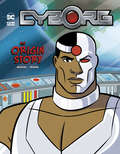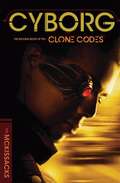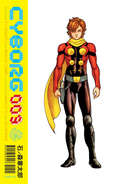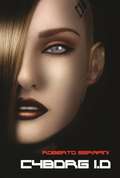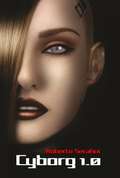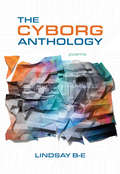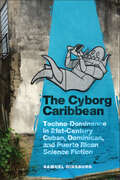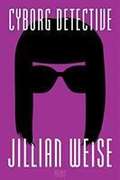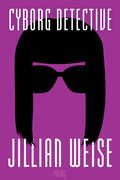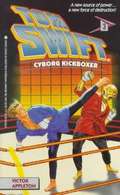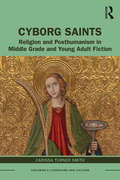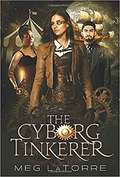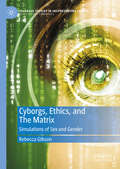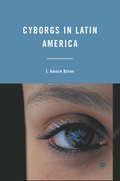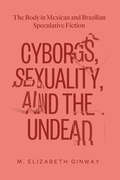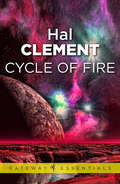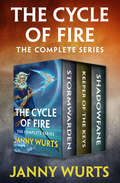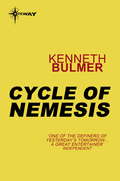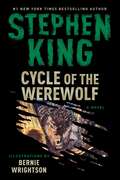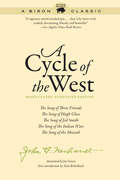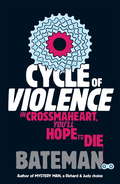- Table View
- List View
The Cybil War
by Betsy ByarsYoung love, told by the Newbery Medal-winning author of Summer of the Swans Simon is in fifth grade, and every time he sees Cybil Ackerman, his heart pounds. Falling in love with her was easy, but winning her is not. Simon's best friend, Tony, is also swooning over Cybil, and he'll stop at nothing to ruin Simon's chances of impressing her. When Simon realizes what Tony is up to, the war is on. . . but only Cybil can decide the outcome. Who will be the lucky winner of Cybil's heart? "Young love, fifth-grade variety, portrayed with warmth and humor and that extra, penetrating touch one expects of Byars. "-Kirkus Reviews An ALA Notable Book .
Cyborg: An Origin Story (DC Super Heroes Origins)
by Matthew K. ManningHow did Cyborg become a member of the Justice League? Discover the story behind Victor Stone's journey from technological experiment to one of the World's Greatest Super Heroes, including the source of his high-tech computing powers. With action-packed illustrations and easy-to-follow text, these early reader books are perfect for young super hero fans.
Cyborg (The Clone Codes #2)
by Patricia C. Mckissack Fredrick L. Mckissack John MckissackSeventeen-Year-Old Houston, a cyborg since the age of seven, and a fugitive living on the moon, joins with other cyborgs all over the world in non-violent protest marches to challenge the cyborg Act of 2130 and hopefully secure increased civil liberties.
Cyborg 009
by F. J. DeSanto Marcus ToAwakening in a futurist military installation with no memory of who he is or how he got there, a young man known only as CYBORG 009 has been stripped by his captors of not only his freedom but also his humanity. His body augmented by cybernetic technology, CYBORG 009 joins forces with 8 other men and women, CYBORG 001-008, and sets off on a journey to learn the truth of why they were turned into weapons of mass destruction, and to prevent a conflict that could very well be the start of World War III.
CYBORG 1.0
by Roberto SerafiniCambridge, 20 de junio de 2020. El día de su graduación, John Miller debe enfrentarse a dos eventos dramáticos que lo cambiarán para siempre. Filadelfia, 21 de octubre de 2030. Cyborg Corporation se está preparando para lanzar al mercado una nueva generación de androides, diseñados por el ingeniero John Miller. El prototipo Venus parece listo para abrirse paso en el mundo de los humanos. Solo faltan unas pocas pruebas finales, en las cuales John quiere participar personalmente. Por esto se quedará unos días solo con su criatura
Cyborg 1.0
by Roberto Serafini Rachel StandringCambridge, 20 June 2020: Engineering student, John Miller is preparing to celebrate his graduation day. But two dramatic events occur that will dictate his future course. Philadelphia, 21 October 2030: the Cyborg Corporation announces the launch of a new generation of androids based on Miller’s designs. The Venus prototype is almost ready to enter the world of humans, and Miller needs just a few days alone with his creature to carry out the final tests. But those few days are going to change life as we know it…
The Cyborg Anthology
by Lindsay B-EPoems written by Cyborgs in the future – this collection melds sci-fi and poetry, human and machine. The Cyborg Anthology takes place in a future where there was a thriving world of Robots and Cyborgs living peacefully beside Humans, but a disaster destroyed all Robot and most Cyborg life. The book is organized like a typical anthology of literature, split into sections that include a biography of each poet and a sample of their poetry. It covers early Cyborg poetry, political, celebrity, and pop culture poets, and ends with the next generation of Cyborg poets. The narrative takes place in the time after a cataclysmic event, and the collection wrestles with this loss. Through the lives of the poets, the book chronicles the history of personhood for technological beings, their struggle for liberation, and demonstrates different ways a person can be Cyborg. The poems and biographies together tell the story of a complex and enthralling world-to-come, exploring topics that are important in the future, and also urgent right now. “With mordant wit and a playful satiric touch, these Cyborg poems showcase a dazzling range of poetic forms and ideas: imaginative and charmingly subversive. Move over Norton Anthology of Poetry, there’s a new force in town, and they are a delight.” —Renée Sarojini Saklikar, author of Listening to the Bees and Children of Air India "The premise of this collection alone is fabulous. The poems are potent and powerful. With echoes of Le Guin, Brunner and Monáe, Lindsay B-e’s debut is layered and smart, provocative, and deeply satisfying. I was moved and fascinated. Speculative poetry at its best." —Hiromi Goto, author of Chorus of Mushrooms and Darkest Light
The Cyborg Caribbean: Techno-Dominance in Twenty-First-Century Cuban, Dominican, and Puerto Rican Science Fiction (Critical Caribbean Studies)
by Samuel GinsburgThe Cyborg Caribbean examines a wide range of twenty-first-century Cuban, Dominican, and Puerto Rican science fiction texts, arguing that authors from Pedro Cabiya, Alexandra Pagan-Velez, and Vagabond Beaumont to Yasmin Silvia Portales, Erick Mota, and Yoss, Haris Durrani, and Rita Indiana Hernandez, among others, negotiate rhetorical legacies of historical techno-colonialism and techno-authoritarianism. The authors span the Hispanic Caribbean and their respective diasporas, reflecting how science fiction as a genre has the ability to manipulate political borders. As both a literary and historical study, the book traces four different technologies—electroconvulsive therapy, nuclear weapons, space exploration, and digital avatars—that have transformed understandings of corporality and humanity in the Caribbean. By recognizing the ways that increased technology may amplify the marginalization of bodies based on race, gender, sexuality, and other factors, the science fiction texts studied in this book challenge oppressive narratives that link technological and sociopolitical progress. .
Cyborg Detective (American Poets Continuum #174)
by Jillian WeiseIn her third collection of poems, Jillian Weise delivers a reckoning to the ableism of the Western Canon. These poems investigate and challenge the ways that nondisabled writers have appropriated disabled bodies, from calling out William Carlos Williams to biohacking Raymond Carver's "Cathedral" to chronicling the ongoing headlines of violence against disabled women. Part invective, part love poem, Cyborg Detective holds a magnifying glass to the marginalization and fetishization of disabled people while claiming space and pride for the people who already use technology and cybernetic implants every day.
Cyborg Detective (American Poets Continuum #174)
by Jillian WeiseIn her third collection of poems, Jillian Weise delivers a reckoning to the ableism of the Western Canon. These poems investigate and challenge the ways that nondisabled writers have appropriated disabled bodies, from calling out William Carlos Williams to biohacking Raymond Carver’s “Cathedral” to chronicling the ongoing headlines of violence against disabled women. Part invective, part love poem, Cyborg Detective holds a magnifying glass to the marginalization and fetishization of disabled people while claiming space and pride for the people who already use technology and cybernetic implants every day.
The Cyborg from Earth (Jupiter Novels #4)
by Charles SheffieldJefferson Kopal, the black sheep of a powerful family dynasty, questions why he is suddenly tapped by the navy for an urgent mission to the far reaches of space.
Cyborg Kickboxer (Tom Swift, #3)
by Victor AppletonTom Swift's invention, a computer-controlled exoskeleton strengthens but also endangers its user. When an unscrupulous boxer threatens to exploit the device, Tom Swift must don the high-risk armor himself.
Cyborg Saints: Religion and Posthumanism in Middle Grade and Young Adult Fiction (Children's Literature and Culture)
by Carissa Turner SmithSaints are currently undergoing a resurrection in middle grade and young adult fiction, as recent prominent novels by Socorro Acioli, Julie Berry, Adam Gidwitz, Rachel Hartman, Merrie Haskell, Gene Luen Yang, and others demonstrate. Cyborg Saints: Religion and Posthumanism in Middle Grade and Young Adult Fiction makes the radical claim that these holy medieval figures are actually the new cyborgs in that they dethrone the autonomous subject of humanist modernity. While young people navigate political and personal forces, as well as technologies, that threaten to fragment and thingify them, saints show that agency is still possible outside of the humanist construct of subjectivity. The saints of these neomedievalist novels, through living a life vulnerable to the other, attain a distributed agency that accomplishes miracles through bodies and places and things (relics, icons, pilgrimage sites, and ultimately the hagiographic text and its reader) spread across time. Cyborg Saints analyzes MG and YA fiction through the triple lens of posthumanism, neomedievalism, and postsecularism. Cyborg Saints charts new ground in joining religion and posthumanism to represent the creativity and diversity of young people’s fiction.
The Cyborg Tinkerer
by Meg LaTorreGwendolyn Grimm intended to seduce men and women across the galaxy while working as a ship tinkerer on the finest vessels in the Crescent Star System. Alas, terminal illness is a buzzkill. When a life-saving opportunity struts into her life dressed in a pinstripe suit, she is made an offer she can't refuse: become a cyborg and work as a tinkerer for Cirque du Borge, the once renowned cyborg circus. <p><p> The problem is, a new law has banned the creation of new cyborgs and becoming one means execution if caught. Thus, no one cares to see the wonders of man and machine anymore. <p><p> Ticket sales continue to fall as the circus announces a competition to determine which acts will perform for the emperor on his home planet-an opportunity with the potential to save the circus from bankruptcy. But the competition has deadly consequences. Losing acts have their cyborg implants forcibly removed, and those who survive the extraction are banished from the circus. <p><p> As the tinkerer, Gwendolyn is forced to perform the revolting task of removing the cyborg implants from the losing performers. When she falls for both the man running the competition and a woman competing in it, she must decide who to protect. But can she risk having to harvest the people she loves the most?
Cyborgs, Ethics, and The Matrix: Simulations of Sex and Gender (Palgrave Studies in (Re)Presenting Gender)
by Rebecca GibsonThe Matrix (Lana Wachowski and Lilly Wachowski 1999) has permeated our cultural consciousness for two decades, working its way into such common parlance as “a glitch in the Matrix,” and the idea of taking the Red Pill. With the release of the fourth movie, The Matrix Resurrections (Lana Wachowski 2021), and the confirmation of the franchise being a metaphor for gender transition, this book examines how the entire franchise contributes to the discourse on sex and gender, and how it has been instrumental in propelling the creation of new types of cyborg technology. This book centers on the main philosophical theme of The Matrix, know thyself, and relate it to the quest for authenticity which creates our identities—be they human, or human “enough”—as we move through the world.
Cyborgs in Latin America
by J. Andrew BrownA PDF version of this book is available for free in open access via the OAPEN Library platform, www. oapen. org . Cyborgs in Latin America explores the ways cultural expression in Latin America has grappled with the changing relationships between technology and human identity.
Cyborgs, Sexuality, and the Undead: The Body in Mexican and Brazilian Speculative Fiction
by M. Elizabeth GinwayWriters in Brazil and Mexico discovered early on that speculative fiction provides an ideal platform for addressing the complex issues of modernity, yet the study of speculative fictions rarely strays from the United States and England. Cyborgs, Sexuality, and the Undead expands the traditional purview of speculative fiction in all its incarnations (science fiction, fantasy, horror) beyond the traditional Anglo-American context to focus on work produced in Mexico and Brazil across a historical overview from 1870 to the present. The book portrays the effects—and ravages—of modernity in these two nations, addressing its technological, cultural, and social consequences and their implications for the human body. In Cyborgs, Sexuality, and the Undead, M. Elizabeth Ginway examines all these issues from a number of theoretical perspectives, most importantly through the lens of Bolívar Echeverría&’s &“baroque ethos,&” which emphasizes the strategies that subaltern populations may adopt in order to survive and prosper in the face of massive historical and structural disadvantages. Foucault&’s concept of biopolitics is developed in discussion with Roberto Esposito&’s concept of immunity and Giorgio Agamben&’s distinction between &“political life&” and &“bare life.&” This book will be of interest to scholars of speculative fiction, as well as Mexicanists and Brazilianists in history, literary studies, and critical theory.
Cycle City
by Alison FarrellWhen little Etta the Elephant goes to her Aunt Ellen's house, she takes a journey through bicycle-filled Cycle City, a town filled with bikes of all kinds! At the end of the day, a special surprise awaits Etta—the most amazing bicycle parade imaginable. Detail-rich illustrations in this fun seek-and-find book paint the colors of this unusual town where everyone rides some kind of bike—whether a penny-farthing, a two-wheeled unicycle, or a conference bike, everyone is on wheels! Packed with prompts and lots to see on every page, this is a sweet story for the sharpest of eyes.
Cycle of Fire (Gateway Essentials #44)
by Hal ClementStranded on an alien planet, light years from home, wandering from blistering heat to searing cold, Nils Kruger was not a happy man. So when he met another being - even though it wasn't human - things seemed to be looking up. The alien might be helpless, or it might be dangerous, but one thing was for sure - they stood a better chance for survival if they worked together.But as the two creatures overcame their mutual suspicion, as they worked together, as the language barrier was broken down, Nils came to a terrifying conclusion - this alien was more intelligent than a human. And to it, Nils was the alien.
The Cycle of Fire: The Complete Series (The Cycle of Fire #3)
by Janny WurtsNow in one volume: three novels in the &“epic tale mixing fantasy and SF . . . full of action, splendid scenes of magic and engaging secondary characters&” (Publishers Weekly). Stormwarden A young girl, her brother, and a Firelord&’s descendant are caught up in the rescue of the Stormwarden Anskiere—and the unbinding of the demons that could destroy all of humanity. Keeper of the Keys As Jaric struggles to accept his father&’s heritage, Taen&’s brother is possessed by the demons who use him as a pawn to hunt down and slay the Firelord&’s heir. Shadowfane Jaric faces the Cycle of Fire that drove his father to madness, while Taen Dreamweaver is targeted by her brother and his demon overlords, psionically endowed aliens who have been revealed as mankind&’s ancient conquerors. Praise for Janny Wurts &“Janny Wurts builds beautiful castles in the air. . . . Every detail is richly imagined and vividly rendered.&” —Diana Gabaldon &“A gifted creator of wonders.&” —Raymond E. Feist &“It ought to be illegal for one person to have this much talent.&” —Stephen R. Donaldson
Cycle of Nemesis
by Kenneth BulmerSeven thousand years ago one of Earth's earliest civilisations was confronted by a menace from the stars - and died in a world-shaking effort to destroy that cosmic monster. But the death of that forgotten empire was not in vain, for they did succeed in entombing that dimension-shaking thing out of sight and harm to humanity. But even their efforts could not make that burial permanent - and after seven millennia the monster stirred again, cracking through the new world of today.
Cycle of Nemesis
by Kenneth BulmerSeven thousand years ago one of Earth's earliest civilisations was confronted by a menace from the stars - and died in a world-shaking effort to destroy that cosmic monster. But the death of that forgotten empire was not in vain, for they did succeed in entombing that dimension-shaking thing out of sight and harm to humanity. But even their efforts could not make that burial permanent - and after seven millennia the monster stirred again, cracking through the new world of today.
Cycle of the Werewolf: A Novel (Booket Ser.)
by Stephen KingThe classic masterpiece by #1 New York Times bestselling author Stephen King—illustrated by the legendary artist Bernie Wrightson!Terror began in January—by the light of the full moon... The first scream came from the snowbound railwayman who felt the werewolf&’s fangs ripping at his throat. The next month there was a scream of ecstatic agony from the woman attacked in her cozy bedroom. Now scenes of unbelievable horror unfold each time the full moon shines on the isolated Maine town of Tarker&’s Mills. No one knows who will be attacked next. But one thing is sure. When the full moon rises, a paralyzing fear sweeps through Tarker's Mills. For snarls that sound like human words can be heard whining through the wind. And all around are the footprints of a monster whose hunger cannot be sated...
A Cycle of the West, Bison Classic Annotated Edition: The Song of Three Friends, The Song of Hugh Glass, The Song of Jed Smith, The Song of the Indian Wars, The Song of the Messiah
by John G. Neihardt Alan BirkelbachA Cycle of the West rewards its readers with a sweeping saga of the American West and John G. Neihardt’s exhilarating vision of frontier history. It is infused with wonder, nostalgia, and a keen appreciation of epic history. Unquestionably the masterpiece of the poet who has been called the “American Homer,” A Cycle of the West celebrates the land and legends of the Old West in five narrative poems: The Song of Three Friends (1919), The Song of Hugh Glass (1915), The Song of Jed Smith (1941), The Song of the Indian Wars (1925), and The Song of the Messiah (1935). This unforgettable epic of discovery, conquest, courage, and tragedy speaks movingly and resoundingly of a unique American experience. The new introduction by former Texas poet laureate Alan Birkelbach and annotations by Joe Green present fresh views of Neihardt’s iconic work.
Cycle of Violence: A Mystery
by BatemanBicycling journalist Miller is exiled from his big-city paper to small-town Crossmaheart. There, he is to replace another reporter, Jamie Milburn, who has disappeared. Not that anyone's all that surprised, since Crossmaheart is a notoriously fatal place in which to ask questions.Miller aims to keep his head down, but as soon as he gets involved with Jamie's girlfriend Marie, that plan, and much else besides, begins to fall apart.Bateman is a master of storytelling, and CYCLE OF VIOLENCE is dark, disturbing and hugely enjoyable.

